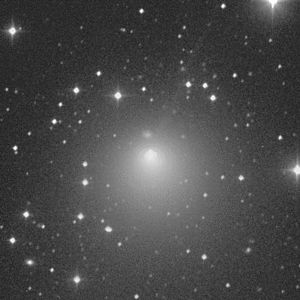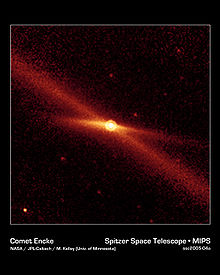- Comet Encke
-
2P/Encke 
Discovery Discovered by: Pierre Méchain Discovery date: 1786 Alternate designations: 1786 I; 1795; 1805;
1819 I; 1822 II; 1825 III;
1829; 1832 I; 1835 II;
1838; 1842 I; 1845 IVOrbital characteristics A Epoch: September 22, 2006 (JD 2454000.5) Aphelion distance: 4.11 AU Perihelion distance: 0.3302 AU Semi-major axis: 2.2178 AU Eccentricity: 0.8471 Orbital period: 3.30 a Inclination: 11.76° Last perihelion: 6 August 2010[1][2] Next perihelion: 21 November 2013[1] Comet Encke or Encke's Comet (official designation: 2P/Encke) is a periodic comet that completes an orbit of the Sun once every three years — the shortest period of any known comet. It was first recorded by Pierre Méchain in 1786, but it was not recognized as a periodic comet until 1819 when its orbit was computed by Johann Franz Encke; like Halley's Comet, it is unusual in being named after the calculator of its orbit rather than its discoverer.
Contents
Discovery
As its official designation implies, Encke's Comet was the first periodic comet discovered after Halley's Comet (designated 1P/Halley). Its orbit was calculated by Johann Franz Encke, who through laborious calculations was able to link observations of comets in 1786 (designated 2P/1786 B1), 1795 (2P/1795 V1), 1805 (2P/1805 U1) and 1818 (2P/1818 W1) to the same object. In 1819 he published his conclusions in the journal Correspondance astronomique, and predicted correctly its return in 1822 (2P/1822 L1).
Characteristics
The diameter of the nucleus of Encke's Comet is 4.8 km.[2]
Comets are in unstable orbits that evolve over time due to perturbations and outgassing. Given Encke's low orbital inclination near the ecliptic and brief orbital period of 3 years, the orbit of Encke is frequently perturbed by the inner planets.[3]
Observations
The failed CONTOUR mission was launched to study this comet, and also Schwassmann-Wachmann 3.
Encke's Comet loses its tail
On April 20, 2007, STEREO-A observed the tail of Comet Encke to be temporarily torn off by magnetic field disturbances caused by a coronal mass ejection (a blast of solar particles from the Sun).[4] The tail grew back due to the continuous shedding of dust and gas by the comet.[5]
Meteor showers
Comet Encke is believed to be the originator of several related meteor showers known as the Taurids (which are encountered as the Northern and Southern Taurids across November, and the Beta Taurids in late June and early July).[6][7]
Near-Earth object 2004 TG10 may be a fragment of Encke.[8]
Effects on Earth
More than one theory has associated Encke's Comet with impacts of cometary material on Earth, and with cultural significance.
The Tunguska event of 1908, probably caused by the impact of a cometary body, has also been postulated by Czechoslovakian astronomer Ľubor Kresák as a fragment of Comet Encke.[9]
A theory holds that the ancient symbol of the swastika appeared in a variety of cultures across the world at a similar time, and could have been inspired by the appearance of a comet from head on, as the curved jets would be reminiscent of the swastika shape (see Comets and the swastika motif). Comet Encke has sometimes been identified as the comet in question. In their 1982 book Cosmic Serpent (page 155) Victor Clube and Bill Napier reproduce an ancient Chinese catalogue of cometary shapes from the Mawangdui Silk Texts, which includes a swastika-shaped comet, and suggest that some of the comet drawings were related to the breakup of the progenitor of Encke and the Taurid meteoroid stream. Fred Whipple in his The Mystery of Comets (1985, page 163) points out that Comet Encke's polar axis is only 5 degrees from its orbital plane: such an orientation is ideal to have presented a pinwheel like aspect to our ancestors when Encke was more active.
Importance in the scientific history of luminiferous aether
Comet Encke (and Biela's Comet) had a role in scientific history in the generally discredited concept of luminiferous aether. As its orbit was perturbed and shortened, the shortening could only be ascribed to the drag of an "ether" through which it orbited in outer space. One reference (see External links) reads:
- Encke's comet is found to lose about two days in each successive period of 1200 days. Biela's comet, with twice that length of period, loses about one day. That is, the successive returns of these bodies is found to be accelerated by this amount. No other cause for this irregularity has been found but the agency of the supposed ether.
See also
References
- ^ a b 2P/Encke past, present and future orbits by Kazuo Kinoshita
- ^ a b NASA JPL Small-Body Database Browser on 2P
- ^ "JPL Close-Approach Data: 2P/Encke". 2008-09-30 last obs. http://ssd.jpl.nasa.gov/sbdb.cgi?sstr=2P;cad=1#cad. Retrieved 2009-05-07.
- ^ "The Sun Rips Off a Comet's Tail". Science@NASA. 2007-10-01. http://science.nasa.gov/headlines/y2007/01oct_encke.htm. Retrieved 2009-10-20.
- ^ Astronomy Picture of the Day 2007 October 3
- ^ http://www.serve.com/~wh6ef/comets/meteors/showers/beta_taurids.html
- ^ Whipple, 1940; Klačka, 1999).
- ^ Porubčan, V.; Kornoš; Williams (2006). "The Taurid complex meteor showers and asteroids". Contributions of the Astronomical Observatory Skalnaté Pleso 36: 103–117. arXiv:0905.1639. Bibcode 2006CoSka..36..103P.
- ^ The Tunguska object - A fragment of Comet Encke. Astronomical Institutes of Czechoslovakia. Bibcode 1978BAICz..29..129K.
- Klačka, Jozef (1999). "Meteor Streams of Comet Encke. Taurid Meteor Complex". Abstract
- Whipple, F.L. (1940). "Photographic meteor studies. III. The Taurid shower." Proc. Amer. Phil. Soc., 83, 711-745.
- Master, S. and Woldai, T. (2004) The UMM Al Binni structure in the Mesopotamian marshlands of Southern Iraq, as a postulated late holocene meteorite impact crater : geological setting and new LANDSAT ETM + and Aster satellite imagery. Johannesburg, University of Witwatersrand, Economic Geology Research Institute (EGRI), 2004. EGRI - HALL : information circular 382, p. 21
http://www.itc.nl/library/Papers_2004/tech_rep/woldai_umm.pdf (1.56 MB)
- Master, S. and Woldai, T. (2004) Umm al Binni structure, southern Iraq, as a postulated late holocene meteorite impact crater : new satellite imagery and proposals for future research. Presented at the ICSU workshop : comet - asteroid impacts and human society, Santa Cruz de Tenerife, Canary Islands, Spain, November 27- December 2, 2004. p. 20
- Hamacher, D. W. (2005) "The Umm Al Binni Structure and Bronze Age Catastrophes", The Artifact: Publications of the El Paso Archaeological Society, Vol. 43
- Hamacher, D. W. (2006) "Umm al Binni lake: Effects of a possible Holocene bolide impact", Astronomical Society of Australia Meeting 40, #15
External links
- Orbital simulation from JPL (Java) / Ephemeris
- 2P/Encke at the Minor Planet Center's Database
- Gary W. Kronk's Cometography page for 2P
- 2P/Encke light curve by Seiichi Yoshida
- Comets and the Bronze Age Collapse
- Solar Storm Tears Tail From Comet Encke
- Animation (on APOD) of Encke's tail being torn away
- HI-1A movie showing Comet Encke (April 2007)
- Importance in history of luminiferous aether, search for Encke's comet
- Study of the April 20, 2007 CME-Comet Interaction Event with an MHD Model (arxiv 0903.4942)
Periodic comets (by number) Previous
1P/Halley2P/Encke Next
3D/BielaCategories:- Comets
- 1780s in science
Wikimedia Foundation. 2010.


